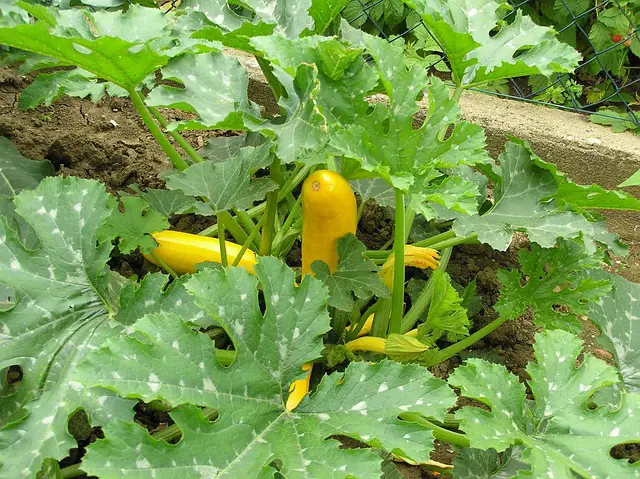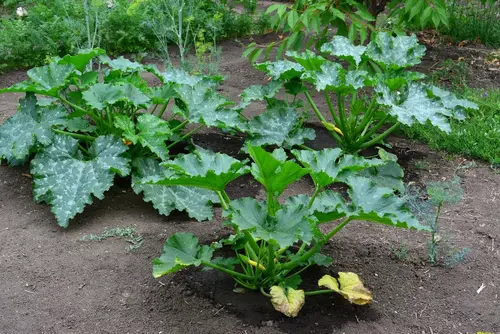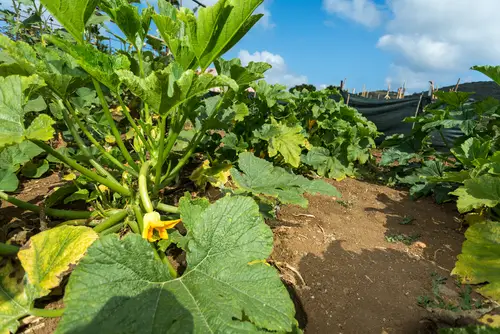Zucchini plants are a popular choice for gardeners, but they can be finicky at times. One common problem that many gardeners face is their zucchini plant leaves turning brown. This can be a frustrating issue, as it can be difficult to determine the root cause of the problem.
Understanding why zucchini plant leaves are turning brown is the first step in solving the problem. There are many potential causes, including overwatering, root damage, sunlight issues, moisture deficiency, lack of nutrients, temperature fluctuation, pest infestation, and disease attacks.
Identifying the specific cause of the problem is key to determining the appropriate treatment. In some cases, preventive measures may be necessary to keep the problem from recurring.
Key Takeaways:
- Understanding the causes of zucchini plant leaves turning brown is crucial in determining the appropriate treatment.
- Identifying specific diseases and pests that may be causing the problem is key to finding a solution.
- Preventive measures, such as proper watering and fertilization, can help keep zucchini plants healthy and free of brown leaves.
Related posts:
Understanding Zucchini Plant Leaves Turning Brown

Zucchini plants are prized for their delicious fruits and ease of cultivation. However, one common issue that gardeners face is the browning of zucchini plant leaves.
When the leaves of a zucchini plant turn brown, it can be a sign of several underlying problems. Understanding these problems is crucial to restoring the health of the plant.
1. Causes of Brown Leaves on Zucchini Plants
There are several reasons why zucchini plant leaves may turn brown. Some of the common causes include:
- Pest infestations: Zucchini plants are vulnerable to pests such as aphids, spider mites, and squash bugs. These pests can cause damage to the leaves, leading to browning.
- Diseases: Fungal diseases such as powdery mildew can cause the leaves of zucchini plants to turn brown and dry up.
- Inadequate watering: Zucchini plants require consistent and adequate watering to thrive. Overwatering or underwatering can cause the leaves to turn brown.
- Nutrient deficiencies: A lack of essential nutrients such as nitrogen, phosphorus, and potassium can cause the leaves to turn brown.
- Lack of sunlight: Zucchini plants require at least 6 hours of direct sunlight daily. A lack of sunlight can cause the leaves to turn brown and stunt the growth of the plant.
2. Diagnosing the Problem
To diagnose the problem, it is important to examine the affected leaves closely. If the leaves are dry and brittle, it may be due to inadequate watering. If the leaves have yellow spots and a powdery coating, it may be due to a fungal disease. If the leaves have holes or are chewed, it may be due to pest infestations.
3. Treating the Problem
The treatment for brown leaves on zucchini plants depends on the underlying cause. For pest infestations, it may be necessary to use insecticides or natural pest control methods such as neem oil or ladybugs. For fungal diseases, fungicides may be necessary.
For nutrient deficiencies, it may be necessary to fertilize the plant with a balanced fertilizer. For a lack of sunlight, it may be necessary to relocate the plant to a sunnier location.
Zucchini Plant Leaves Turning Brown – 4 Common Problems
Zucchini plant leaves turning brown is a common problem for gardeners. There are several reasons why this may happen, including overwatering and underwatering, disease and fungal infections, pests and insects, and nutrient deficiencies. In this section, we will discuss each of these causes in detail.
1. Overwatering and Underwatering

One of the most common causes of brown leaves on zucchini plants is overwatering or underwatering. Overwatering can lead to root damage and suffocation, which can cause the leaves to turn brown and wilt. On the other hand, underwatering can cause the leaves to dry out and turn brown.
To avoid overwatering or underwatering, gardeners should water their zucchini plants regularly, but not excessively. They should also make sure that the soil is well-draining and not waterlogged.
2. Disease and Fungal Infections
Diseases and fungal infections can also cause zucchini plant leaves to turn brown. Bacterial wilt, for example, is a disease that causes the leaves of the zucchini plant to turn brown and wilt. Other fungal infections, such as powdery mildew, can also cause the leaves to turn brown and become covered in a white powdery substance.
To prevent diseases and fungal infections, gardeners should make sure that their zucchini plants are planted in well-draining soil and are not overcrowded. They should also remove any infected leaves or plants immediately to prevent the spread of the disease.
3. Pests and Insects
Pests and insects can also cause brown leaves on zucchini plants. Aphids, for example, can suck the sap from the leaves, causing them to turn brown and wilt. Other pests, such as spider mites and thrips, can also cause damage to the leaves of the zucchini plant.
To prevent pests and insects, gardeners should monitor their zucchini plants regularly and use insecticides or other pest control methods as necessary.
4. Nutrient Deficiencies
Nutrient deficiencies can also cause zucchini plant leaves to turn brown. Calcium, copper, iron, manganese, nitrogen, potassium, sulfur, and zinc are all essential nutrients that the zucchini plant needs to grow and thrive. If any of these nutrients are lacking, the leaves may turn brown and become stunted.
To prevent nutrient deficiencies, gardeners should make sure that their zucchini plants are planted in nutrient-rich soil and are fertilized regularly. They should also monitor the leaves for any signs of nutrient deficiencies and adjust their fertilization schedule accordingly.
Identifying Specific Diseases and Pests
Zucchini plant leaves turning brown can be a sign of various diseases and pests that can affect the plant’s health and yield. Identifying the specific disease or pest is crucial to determine the appropriate treatment. Here are some common diseases and pests that can cause brown leaves on zucchini plants:
1. Fusarium and Alternaria Leaf Blight

Fusarium and Alternaria leaf blight are fungal diseases that affect zucchini plants. Fusarium blight causes the leaves to wilt and turn yellow or brown, while Alternaria blight causes brown spots with yellow halos on the leaves. Both diseases can spread quickly and cause severe damage to the plant.
To prevent these diseases, it is essential to maintain good sanitation practices, such as removing infected plant debris, and avoid overhead watering. Fungicides can also be used to control the spread of the disease.
2. Cucumber Mosaic Virus and Bacterial Wilt
Cucumber mosaic virus and bacterial wilt are viral and bacterial diseases that can cause brown leaves on zucchini plants. Cucumber mosaic virus causes the leaves to curl and become mottled, while bacterial wilt causes the leaves to wilt and turn brown. These diseases can spread rapidly and cause significant damage to the plant.
To prevent the spread of these diseases, it is essential to remove infected plants and control the insect vectors that can transmit the diseases. Insecticides can also be used to control the spread of the disease.
3. Powdery and Downy Mildew
Powdery and downy mildew are fungal diseases that can cause brown leaves on zucchini plants. Powdery mildew causes a white powdery coating on the leaves, while downy mildew causes yellow or brown spots on the leaves. Both diseases can spread quickly and cause significant damage to the plant.
To prevent these diseases, it is essential to maintain good ventilation and avoid overhead watering. Fungicides can also be used to control the spread of the disease.
4. Vine Borers and Spider Mites
Vine borers and spider mites are common pests that can cause brown leaves on zucchini plants. Vine borers lay eggs on the stem of the plant, and the larvae bore into the stem, causing the leaves to wilt and turn brown. Spider mites suck the sap from the leaves, causing them to turn brown and dry.
To prevent these pests, it is essential to use insecticides and maintain good sanitation practices, such as removing infected plant debris. Insecticidal soaps and oils can also be used to control the spread of the pests.
Preventive Measures and Treatment
1. Proper Watering and Fertilizing
One of the main reasons why zucchini plant leaves turn brown is due to over or under-watering. Proper watering techniques are crucial to maintaining healthy zucchini plants.
Zucchini plants need consistent moisture, but not too much. The soil should be moist but not waterlogged. It is important to water the plants at the base, avoiding the leaves, to prevent fungal growth.
Fertilizing is also important for zucchini plants to grow healthy and strong. It is recommended to use a balanced fertilizer with equal parts of nitrogen, phosphorus, and potassium. Over-fertilizing can also cause damage to the plant, so it is important to follow the recommended dosage.
2. Using Fungicides and Pesticides

Fungicides and pesticides can be used to prevent and treat fungal and insect infestations that can cause brown leaves on zucchini plants.
It is important to use organic and environmentally-friendly products to avoid harming beneficial insects and pollinators. Neem oil is a natural fungicide and pesticide that can be used to treat common zucchini plant diseases and pests.
3. Crop Rotation and Pruning
Crop rotation and pruning are important preventive measures to avoid fungal and bacterial diseases that can cause brown leaves on zucchini plants. Crop rotation involves planting different crops in the same spot each year to prevent soil-borne diseases.
Pruning involves removing damaged or diseased leaves and branches to promote healthy growth and prevent the spread of disease.
4. Disease-Resistant Varieties and Floating Row Covers
Planting disease-resistant zucchini varieties and using floating row covers can also prevent and treat brown leaves on zucchini plants. Disease-resistant varieties have been bred to resist common zucchini plant diseases. Floating row covers can be used to protect the plants from insect pests and extreme weather conditions.
Additional Care for Healthy Zucchini Plants
Zucchini plants are relatively easy to grow, but they do require some care to stay healthy and productive. In this section, we’ll cover some additional care tips to help you grow healthy zucchini plants.
1. Soil and Sunlight Requirements
Zucchini plants require well-draining soil that is rich in organic matter. Sandy soil is ideal, but any well-draining soil will do. It’s important to test your soil to determine its pH level and nutrient content. You can do this with a soil test kit or by sending a sample to a soil testing lab.
Zucchini plants also require full sun to thrive. They need at least 6-8 hours of direct sunlight each day. If your garden doesn’t get full sun, you can still grow zucchini plants, but you may need to choose a spot that gets the most sun possible.
2. Dealing with Weather Conditions

Zucchini plants are sensitive to cold and rain. If you live in a cold climate, it’s best to wait until after the last frost to plant your zucchini seeds. If you live in a rainy climate, make sure your zucchini plants have good drainage to prevent root rot.
In hot weather, zucchini plants may wilt in the afternoon sun. This is normal and doesn’t necessarily mean the plant is in distress. However, if the plant is wilting in the morning or evening, it may be a sign of root damage or lack of nutrients.
3. Recognizing and Addressing Other Problems
Zucchini plants can be susceptible to a variety of problems, including pests, diseases, and nutrient deficiencies. Here are some common problems and how to address them:
- Mottled or distorted leaves: This can be a sign of a viral or bacterial disease. Remove any infected leaves and treat the plant with a fungicide.
- Yellow spots or yellowing leaves: This can be a sign of a nutrient deficiency. Make sure your zucchini plants are getting enough fertilizer and water.
- Flowers falling off the plant: This is normal for zucchini plants. The male flowers will fall off after pollination, while the female flowers will develop into fruits.
- Deformed or curled leaves: This can be a sign of insect damage or a herbicide injury. Check the plant for pests and avoid using herbicides near your zucchini plants.
By following these additional care tips, you can help ensure that your zucchini plants stay healthy and productive throughout the growing season.
Frequently Asked Questions
What causes zucchini leaves to turn brown?
There are several reasons why zucchini leaves may turn brown. One common reason is a lack of sunlight. Zucchini plants require a minimum of six hours of sunlight per day to thrive.
Another possible cause is overwatering, which can lead to root rot and other fungal diseases. Insects and pests can also damage the leaves, causing them to turn brown.
What are some common problems with zucchini plants?
Zucchini plants are susceptible to a number of problems, including fungal diseases, insect infestations, and poor soil quality. Some common problems include powdery mildew, bacterial wilt, and squash bugs.
Additionally, zucchini plants may suffer from nutrient deficiencies, which can cause stunted growth and poor fruit production.
How can I prevent my zucchini plant leaves from turning brown?
To prevent zucchini plant leaves from turning brown, it is important to provide adequate sunlight and water. Zucchini plants require well-draining soil and should be watered deeply once or twice per week.
Additionally, it is important to monitor for pests and diseases and treat them promptly. Regular fertilization can also help to keep plants healthy and prevent nutrient deficiencies.
What are some signs of overwatering zucchini plants?
Overwatering can lead to root rot and other fungal diseases, which can cause zucchini plant leaves to turn brown and wilt.
Signs of overwatering include yellowing leaves, stunted growth, and a mushy or rotten smell coming from the soil. To prevent overwatering, it is important to allow the soil to dry out slightly between waterings.
Can brown zucchini leaves be saved?
In some cases, brown zucchini leaves can be saved by addressing the underlying problem. For example, if the leaves are turning brown due to a lack of sunlight, moving the plant to a sunnier location may help.
If the problem is due to overwatering, reducing the frequency of watering may be necessary. However, if the leaves are severely damaged or diseased, it may be best to remove them to prevent the problem from spreading.
How do I treat bacterial wilt in zucchini plants?
Bacterial wilt is a serious disease that can quickly kill zucchini plants. The first sign of bacterial wilt is usually wilting or browning of the leaves.
Unfortunately, there is no cure for bacterial wilt, and infected plants should be removed and destroyed to prevent the disease from spreading. To prevent bacterial wilt, it is important to keep plants healthy and free from pests and diseases.

Hey, I’m Lisa and I’ve been an avid gardener for over 30 years. I love writing, talking and living in the garden! Feel free to connect with me on my socials below


